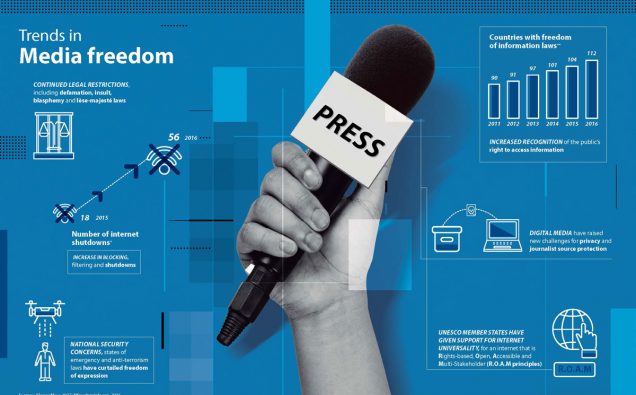
The 2022 World Press Freedom Index reveals a two-fold increase in polarisation amplified by information chaos – that is, media polarisation fuelling divisions within countries, as well as polarization between countries at the international level.
Published by Reporters Without Borders, also known as RSF, the 20th edition, assessing the state of journalism in 180 countries and territories, ays media polarisation is feeding and reinforcing internal social divisions in democratic societies such as the United States (42nd), despite president Joe Biden’s election.
The increase in social and political tension is being fuelled by social media and new opinion media, especially in France (26th). The suppression of independent media is contributing to a sharp polarization in “illiberal democracies” such as Poland (66th), where the authorities have consolidated their control over public broadcasting and their strategy of “re-Polonising” the privately-owned media.
The trio of Nordic countries at the top of the Index – Norway, Denmark, and Sweden – continues to serve as a democratic model where freedom of expression flourishes, while Moldova (40th) and Bulgaria (91st) stand out this year thanks to a government change and the hope it has brought for improvement in the situation for journalists even if oligarchs still own or control the media.
The invasion of Ukraine (106th) by Russia (155th) at the end of February reflects this process, as the physical conflict was preceded by a propaganda war.
China (175th), one of the world’s most repressive autocratic regimes, uses its legislative arsenal to confine its population and cut it off from the rest of the world, especially the population of Hong Kong (148th), which has plummeted in the Index.
The Index finds that confrontation between “blocs” is growing, as seen between nationalist Narendra Modi’s India (150th) and Pakistan (157th). The lack of press freedom in the Middle East continues to impact the conflict between Israel (86th), Palestine (170th), and the Arab states.
The Press freedom situation is classified as “very bad” in a record number of 28 countries in this year’s Index, while 12 countries, including Belarus (153rd) and Russia (155th), are on the Index’s red list (indicating “very bad” press freedom situations) on the map. The world’s 10 worst countries for press freedom include Myanmar (176th), where the February 2021 coup d’état set press freedom back by 10 years, as well as China, Turkmenistan (177th), Iran (178th), Eritrea (179th), and North Korea (180th).
Reporters Without Borders Secretary-General Christophe Deloire says: “Margarita Simonyan, the Editor in Chief of RT (the former Russia Today), revealed what she really thinks in a Russia One TV broadcast when she said, ‘no great nation can exist without control over information.’ The creation of media weaponry in authoritarian countries eliminates their citizens’ right to information but is also linked to the rise in international tension, which can lead to the worst kind of wars.
The latest edition emphasizes that urgent decisions are needed in response to these issues, promoting a New Deal for Journalism, as proposed by the Forum on Information and Democracy, and adopting an appropriate legal framework, with a system to protect democratic online information spaces.”
In Asia, Press freedom has deteriorated dramatically, as evidenced by two major events. In Burma, the military coup of 2021 led to the extremely harsh repression of journalists. As a result, the country, ranked at the low end of RSF’s World Press Freedom Index (176th of 180), has become one of the world’s largest prisons for media professionals. In Afghanistan (156th), the Taliban’s seizure of power has further worsened conditions for reporters and news organizations, who are the targets of all forms of intimidation and violence.
The Asia-Pacific region, which holds more than half of the world’s population, is also affected by more structural issues. The first of these is the policy of absolute control of information by the government. While North Korea (180th) is the worst country for press freedom, China (175th) continues to extend its information control model not only within its borders but also beyond them. Thus, the semi-autonomous region of Hong Kong (148th), now controlled by Beijing, has registered the steepest drop in the ranking (68 places) in the 2022 Index. The governments of Vietnam (174e) and Singapore (139e) have also tightened their grip on the media.
In countries reputed to be more democratic, the media face pressure from increasingly authoritarian and/or nationalist governments, such as India (150th), Sri Lanka (146th), and the Philippines (147th). Some critical journalists are targets of intense harassment campaigns, such as the one aimed at Nobel Peace Prize laureate Maria Ressa.
This region’s media also fall prey to the growing control of large industrial groups, whose influence encourages the self-censorship of journalists and editorial staff, as is the case, for example, in Japan (71st), South Korea (43rd), and Australia (39th).
Meanwhile, UN Secretary-General Antonio Guterres has called for respecting the rights and protecting journalists and media workers who he said are facing “increasing politicization” of their work and growing threats to their freedom to simply do their jobs.
On the occasion of World Press Freedom Day, he said that the day shines a spotlight on the essential work they do, bringing those in power to account, with transparency, “often at great personal risk”.
“Throughout the COVID-19 pandemic, many media workers have been on the frontlines, providing accurate, science-based reporting to inform decision-makers and save lives”, the secretary-general said.
“At the same time, journalists who cover climate, biodiversity, and pollution have succeeded in bringing global attention to this triple planetary crisis,” he said.















